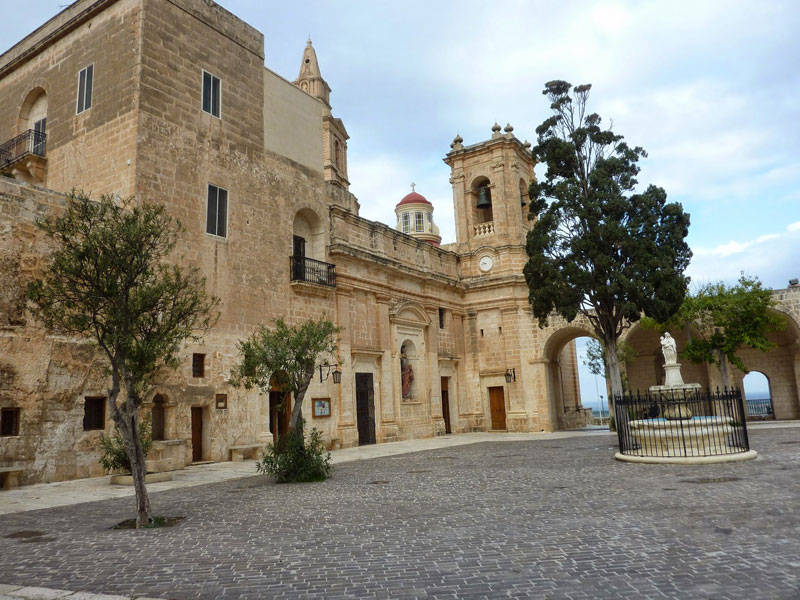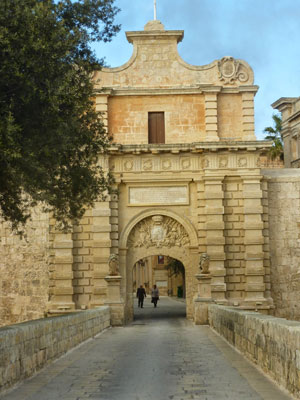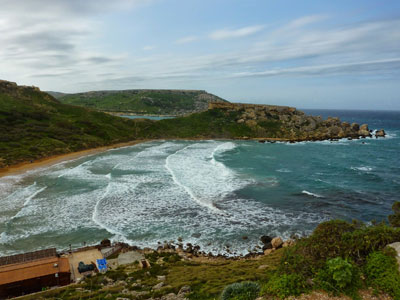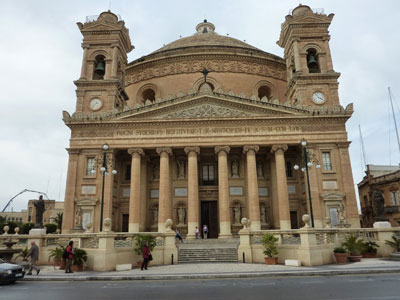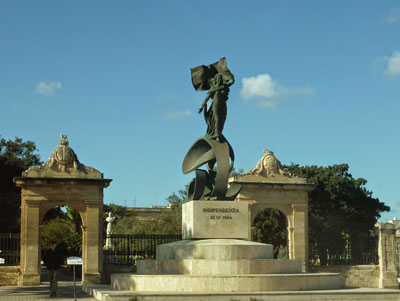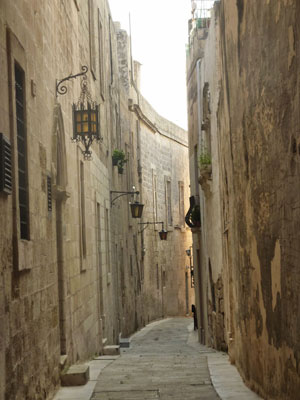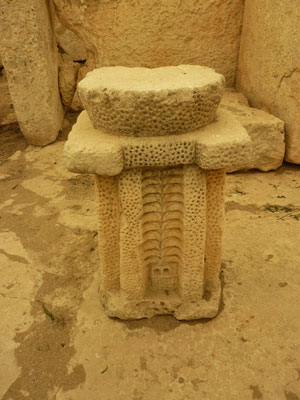Discovering a destination worth devoting some time to on a first-time visit to the Mediterranean island of Malta
This article appears on page 6 of the August 2014 issue.
by Judith Anshin; Contributing Editor
I had wanted to visit Malta for many years, though I had thought of it as a place for a short visit on the way to or from some other place. When I finally went there in mid-February 2014, I discovered that Malta has so much to offer the traveler that it should be a primary destination and visitors should stay at least a week, preferably longer.
Elegant accommodations
I was a guest of the Corinthia Palace Hotel & Spa (De Paule Ave; phone +356 21 440301) and the Malta Tourism Authority. The Corinthia Palace Hotel & Spa is located in San Anton, a village near Valletta, the capital of Malta. An Italianate villa built as a private residence, the property was purchased by Paul Pisani in 1959, before tourism was established on the island, with the plan to create a first-class restaurant. His four sons carried out his dream after his death.
After Malta’s independence in 1964, the brothers extended the villa into the 5-star hotel and spa it is today.
All the public spaces in the hotel are on a grand, elegant scale, with an ambiance that is welcoming and relaxed. I found all the staff throughout the hotel to be very friendly and helpful, and the service was never intrusive.
My room had all the amenities one expects from a 5-star hotel, and the quiet setting meant a peaceful night’s sleep every night.
I enjoyed two massages in the spa, one on the first day and the other on the second-to-last day. I needed both very much, as I was 24 hours in transit traveling to Malta from the West Coast. After a late-night arrival and too little sleep, the massage was both relaxing and rejuvenating.
The second massage was necessary to relax my leg muscles after all the walking I did, especially on the hilly streets of Valletta.
Sacred sites
Malta is such a small island that the Corinthia is ideally situated; it’s within a short drive of everything. The first day’s visit to the Rotunda of Mosta was a wonderful introduction to the recent history of Malta.
During World War II, Malta was an important naval and air force base for the British, so it was heavily bombed by the German Luftwaffe. Much of the island was destroyed, and life was extremely difficult for her citizens.
One bomb fell on the rotunda, also known as the Mosta Church of the Assumption of Our Lady, while several hundred people were sheltered inside. The bomb fell through the dome but did not explode and no one was injured. The unexploded bomb is now in the National Museum of Archaeology in Valletta, but a copy sits in a small museum behind the church.
When the dome was repaired, one square was left unpainted to make the entry point easily identifiable.
Because of the courage of the Maltese people during the war, King George VI awarded the George Cross, the highest British award for civilian bravery, to all of the Maltese people. The cross is now the only symbol on the Maltese flag.
On another part of the island, the parish church of Mġarr is topped by an oval dome, reflecting the source of funds with which it was built: money raised from the local sale of eggs. The church has a beautiful setting, dominating the landscape.
Malta has such a long history, having had so many occupiers who left their marks on the country, that it is impossible to cover all of it in one short visit. It has nine UNESCO World Heritage Sites, the Hal Saflieni Hypogeum being probably the most famous among them. It is the only known prehistoric underground temple in the world, and more than 7,000 remains were found within it.
The site was discovered in 1902 in a residential area when a well was being dug; excavation began in 1906. Adjacent properties were purchased and torn down in order to fully excavate the site.
From the outside, the entrance looks like a normal building, but, inside, the ruins have been excavated down to three levels. The oldest remains in this burial site date to 3000 BC.
Entrance to the site costs €30 ($41), and tickets must be booked in advance online (HeritageMalta.org). Visits are limited to 10 people at a time (60 per day) to avoid additional damage to the limestone walls caused by the exhalation of carbon dioxide by guests. At various times the site is closed for short periods while the air is cleansed.
Visitors first watch a video, then proceed on a tour using individual audio guides. I was very impressed with how well it was done. Note: Photography is not allowed.
Many of the rooms in the hypogeum were painted with spirals in red ochre. This spiral design is featured in jewelry and other handicrafts of Malta.
In the main chamber, a beautiful, small statue called the “Sleeping Lady” was found during excavations. It is now housed in the National Museum of Archaeology, and it, too, is depicted on jewelry and in replica statues.
Gozo
A day trip to the smaller island of Gozo proved to be interesting. The car ferry was comfortable and fast, and, for those traveling alone, I noticed that many tour guides offering their services were available upon landing. Since it was a Saturday, many locals were on the ferry, going to enjoy a day on the island.
The G˙gantija Temples, another UNESCO World Heritage Site, consists of two temples dating back to 3600-3200 BC. As the name implies, these temples are enormous, covering approximately 10,000 square feet, and some of the walls stand approximately 20 feet high. They are the oldest freestanding Neolithic temples in the world, older even than the Egyptian pyramids.
Built in a cloverleaf design, each temple has various chambers that were once roofed but are now open to the air. They were built before the people had metal tools, so the cutting and fitting of the stones is impressive.
While a slightly softer local limestone was used for the inner walls, the outer walls were built from a harder limestone. Spiral decorations painted in red ochre are found there as well.
Victoria, once called Rabat, is the main town on Gozo, and it is crowned by the citadel of Il-Kastell. The narrow, hilly streets within the citadel provide a glimpse into an old way of life. From the top, there is a panoramic view.
Lunch at one of the restaurants off the square near the cathedral was a wonderful experience. Ta´ Rikardu (Triq il-Fosos, Victoria) is housed in an old stone building with upper and lower dining areas.
One surprise, for me, was the popularity of rabbit in Malta. Since I don’t eat red meat, I did not partake, but those who did pronounced it very good.
Portions are often quite large in Malta, and after a starter, entrée, dessert and beverage, we all were quite sated.
Prices in Malta are higher than I expected, and lunch for one with a starter, entrée and beverage cost around €25 ($34). However, such a hearty lunch means one can go much lighter for dinner.
All the meals I had during my visit were of outstanding quality and taste. A visitor will never go hungry there!
After lunch we had a quick visit to the salt pans, shallow pools along the shoreline that date to the first century AD. These pools have formed naturally through erosion, and locals have harvested and sold the salt from there for centuries.
Valletta
Exploring Valletta in one day was very tiring but, oh, so rewarding. We began with the Teatru Manoel, a small theater seating 623 in three tiers of wooden boxes. The oval-shaped hall is topped by a trompe-l’oeil ceiling that creates the illusion of a round room. The 22k gold leaf and vibrant blue paint decorating the ceiling make it visually spectacular. The theater is said to be older than La Scala in Milan, Italy, and it has a collection of 44,000 costumes, all catalogued and preserved.
Our guide stated that the Knights of St. John were not modest, and their Co-Cathedral certainly underscores that. St. John’s Co-Cathedral is so ornate, it made the Manoel theater look somber by comparison!
Built in the 1500s with a plain façade, nearly every inch of the interior is covered in gilt and ornamentation. The marble floors are works of art, and each of the eight side chapels is devoted to one of the divisions of the Knights.
Enormous statues and paintings are everywhere. Off the main church is the Oratory, which houses Caravaggio’s largest painting, “The Beheading of St. John the Baptist.” The artist signature can be seen in the blood that is shown running from St. John’s severed head. Another, smaller Caravaggio, “St. Jerome Writing,” hangs on a separate wall.
One could easily spend the greater part of a day examining the Co-Cathedral in detail.
The Grand Masters’ Palace State Rooms, a short walk from the Co-Cathedral, is currently the seat of the Maltese Parliament and President. It features grand hallways and rooms, with beautifully decorated ceilings and floors, along with medieval armor and weapons. It, too, reinforces the fact that the Knights did things on a grand scale.
Notable sights
My favorite place in Valletta, however, was the Casa Rocca Piccola. A 16th-century palazzo, it is the ancestral home of the Marquis de Piro. The current marquis, Nicholas de Piro, opened it to the public as a museum, and we were fortunate enough to bump into him just as we entered the palazzo. He immediately undertook the responsibility of guiding us through his lovely home.
His passion for his family history and his country was infectious, and his stories made everything come alive. I especially liked the way he has merged the modern with the ancient. In one room, the walls were covered in paintings of his ancestors, but on the piano and tabletops were small framed photos of his immediate family.
Even without the marquis as your guide, the casa is well worth a visit. I was sorry we couldn’t spend more time there.
For a good view of the Grand Harbour, visit the Upper Barrakka Gardens. Even though it was too early for the flowers to be in bloom, it is a very attractive and well-laid-out garden, offering spectacular views across the harbor to the Three Cities, the first home of the Knights of St. John. The Three Cities celebrates holy days and feast days on a scale unlike anywhere else in Malta, with the Easter procession being the most famous.
St. Paul’s Catacombs and the old capital city of Mdina ended our day in Valletta and its environs. With its high walls and hilltop location, Mdina is visually captivating. Known as the Silent City, especially at night, the streets wend around, revealing ever-more-interesting and photogenic buildings and decorations.
I was quite tired by the time we reached Mdina, about 5 p.m., but felt an adrenalin rush when I saw the beautiful surroundings. I could hardly put my camera down for a moment!
So much to do…
My final day on Malta featured visits to the archaeological museum and two important temples. The museum houses the originals of many of the replicas I had seen in the Hypogeum and other temples, and it was thrilling to see them so close. But the temples, Hagar Qim and Mnajdra, were the perfect way to end my visit.
Situated on a hill overlooking the coast and the uninhabited islet of Fifla, the temple ruins are protected by enormous canvas awnings to preserve them.
It is believed that both temples were built to align with the movement of the sun, and displays inside the visitors’ center illustrate the various places the sun would have penetrated the structures at different times of the year.
Also on display are replicas of the “fat lady” and Venus of Malta statues, which were found at these sites.
Hagar Qim also features a megalith weighing more than 20 tons.
To reach Mnajdra, which features three temples, one must walk quite a distance downhill. There are no benches along the way, and the walk back uphill at the end of the morning made me quite ready for lunch.
My short visit to Malta was incredibly busy, making me realize how much there is to see and do there. The beaches around St. George’s Bay draw swimmers and snorkelers in the summer, and the Corinthia Palace Hotel features a complimentary shuttle to its sister hotel on the bay, where guests of the Corinthia may swim.
Golfers can take another shuttle to the Royal Malta Golf Club, and, for garden lovers, across the street from the hotel are the home and gardens of the President of Malta; the gardens are open to the public.
There is also a complimentary shuttle to Valletta, so one doesn’t need to do it all in one day, as I did. Indeed, it would be wonderful to spend several days wandering Valletta, enjoying the architecture and ambiance.
For hikers, there are many hiking paths around the island.
On the plane to London, I met a couple from the Channel Islands who spent six weeks on Malta, and, while they initially feared they might get bored, once there they discovered so much to do, they felt the time went by too quickly. I envied them the long visit and will be sure to make my next visit longer!
I will be happy to answer any questions about the hotel and trip (penguinatlaw@gmail.com). For more information about travel to Malta, contact the Malta Tourism Authority (for the New York, NY, office, phone 646/309-8398).

